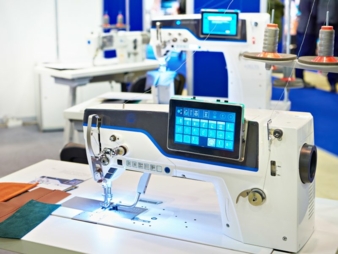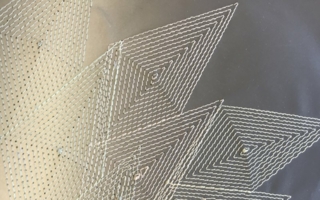04/06/2024 – Industrial sewing machines
Maximizing productivity
The global industrial sewing machine market is anticipated to experience significant growth, driven by factors such as rising demand for advanced sewing solutions in the apparel and textile industries, technological innovations, and the increasing need for automation in manufacturing processes. The global market is expected to grow at US$ 3.5b by the end of 2031, up from US$ 2.4b in 2024. The market is projected to expand at a CAGR of 5.2% during the forecast period between 2024 and 2031, according to a report published by Persistence Market Research.
Industrial sewing machines are designed to handle high-volume sewing tasks with precision and speed. Unlike domestic sewing machines, these machines are built for durability and continuous operation, making them ideal for factory settings. They come equipped with powerful motors, advanced stitch mechanisms, and a variety of specialized functions tailored to specific sewing tasks.
Key features enhancing productivity
High-speed operation: One of the primary advantages of industrial sewing machines is their high-speed operation. Capable of stitching thousands of stitches per minute, these machines significantly reduce the time required to complete sewing tasks. This rapid stitching capability is essential for meeting the high demand and tight deadlines typical in the clothing industry.
Automation and programmability: Modern industrial sewing machines offer advanced automation and programmability features. These include automatic thread trimming, automatic needle positioning, and programmable stitch patterns. Automation reduces the need for manual intervention, minimizes errors, and ensures consistent stitch quality, thereby enhancing overall productivity.
Specialized machines for specific tasks: Industrial sewing machines are available in various specialized models designed for specific tasks such as buttonholing, zigzag stitching, overlocking, and embroidery. Using the right machine for each task ensures optimal performance and quality, further boosting productivity.
Durability and reliability: Built to withstand the rigors of continuous use, industrial sewing machines are highly durable and reliable. Their robust construction reduces downtime due to maintenance and repairs, ensuring a steady production flow. The longevity of these machines also translates to cost savings over time.
Advanced materials handling: Industrial sewing machines are equipped with advanced materials handling capabilities, allowing them to sew through multiple layers of fabric, heavy materials like denim and leather, and delicate fabrics without compromising on stitch quality. This versatility is crucial for manufacturers dealing with a diverse range of clothing items.
Impact on production efficiency
Reduced production time: The high-speed and automated features of industrial sewing machines directly contribute to reduced production times. Tasks that would take hours with manual sewing can be completed in a fraction of the time, allowing manufacturers to increase their output and meet higher order volumes.
Improved consistency and quality: Consistency in stitch quality is vital for maintaining the standard of finished garments. Industrial sewing machines ensure uniform stitching, reducing the likelihood of defects and rework. This consistency leads to higher customer satisfaction and fewer returns or complaints.
Enhanced worker productivity: By automating repetitive tasks and reducing manual labor, industrial sewing machines enable workers to focus on more complex and value-added activities. This shift not only improves individual productivity but also contributes to better job satisfaction and skill development among workers.
Scalability: Industrial sewing machines allow manufacturers to scale their operations easily. Whether expanding production lines or introducing new product lines, these machines can handle increased workloads without compromising performance. This scalability is essential for growing businesses and adapting to market demands. Emerging trends and technologies
Integration with industry 4.0: The integration of industrial sewing machines with Industry 4.0 technologies is revolutionizing the clothing manufacturing sector. Smart factories equipped with interconnected machines, IoT sensors, and data analytics can monitor and optimize production processes in real-time. This connectivity enhances efficiency, reduces waste, and enables predictive maintenance.
Computerized sewing machines: Computerized industrial sewing machines offer advanced control and precision. Features such as touchscreen interfaces, software integration, and digital pattern storage allow for intricate designs and customization. These machines are particularly beneficial for high-end fashion and bespoke clothing manufacturers.
Energy efficiency: As sustainability becomes a priority, manufacturers are increasingly adopting energy-efficient sewing machines. These machines consume less power without compromising performance, contributing to reduced operational costs and a smaller environmental footprint. Energy-efficient models often incorporate advanced motor technology and intelligent power management systems.
Ergonomic designs: Ergonomic designs are becoming a key focus in the development of industrial sewing machines. Adjustable workstations, user-friendly interfaces, and ergonomic seating arrangements help reduce physical strain on workers, leading to improved productivity and reduced workplace injuries.
Automation and robotics: The use of robotics and automation in sewing is expanding. Automated sewing systems, including robotic arms and automated fabric handling systems, can perform complex sewing tasks with high precision and speed. These advancements are particularly useful in high-volume production settings where consistency and efficiency are paramount.
In conlusion, adopting industrial sewing machines involves challenges: high initial investment, need for specialized training, and regular maintenance to prevent downtime. Manufacturers must stay agile to adapt to changing fashion trends. Despite these challenges, the benefits of increased productivity and efficiency make them essential for a competivive advantage in clothing manufacturing.




